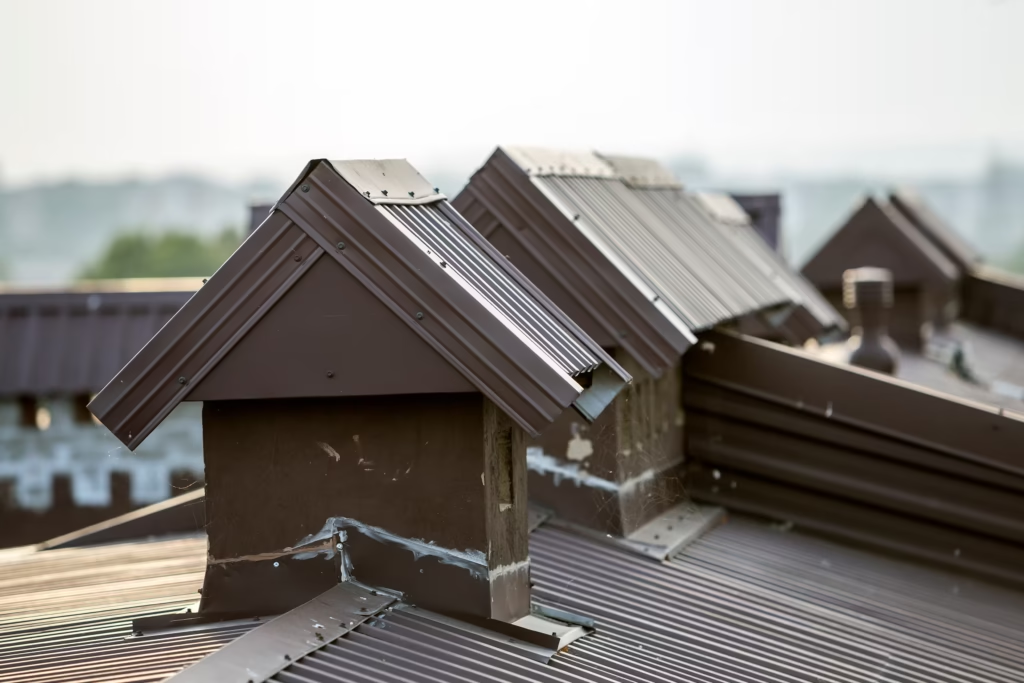The architects and engineers consider the construction of the industrial, commercial, or large-scale building with one common challenge: bringing in natural daylight and ventilation, without compromising strength and beauty.
The monitor roof thus offers a tried-and-proven way. It remains a functioning and aesthetic feature in warehouses, factories, and pre-engineered buildings.
The roof monitors make a modern comeback. So, what is a roof monitor, and why is it becoming popular again? Let’s find out.
What is a Roof Monitor?
A roof monitor is an elevated structure constructed along the ridge of a roof with vertical sides that usually include windows, louvers, or openings. It is a narrow, long clerestory that sits on the roof.
Roof monitors were initially brought into factories and barns to offer daylight and ventilation before using mechanical systems. They continue to be used today for their usefulness and architectural purposes.
You may also like – Best PEB Shed Manufacturer in India
Roof Monitors in PEB (Pre-Engineered Buildings)
Roof monitors are crucial in the context of pre-engineered buildings (PEBs). PEBs are present in warehouses, industrial buildings, and logistics hubs, where expansive covered spaces require cost-effectiveness and low energy utilization.
The ways roof monitors aid PEBs:
- Ventilation: Roof monitors prevent hot air from being trapped as they let it out naturally, thus minimizing the use of HVAC(Heating, Ventilation, and Air Conditioning) systems.
- Daylighting: Well-designed roof monitors provide diffused sunlight to the facility, reducing daytime electricity bills.
- Energy Efficiency: Since less artificial lighting and improved airflow exist, roof monitor-equipped PEBs exhibit improved sustainability parameters.
- Design Flexibility: Roof monitors can be prefabricated and easily installed in steel buildings, providing strength and aesthetics.
Benefits of Roof Monitors

A comfortable indoor environment is achieved through natural ventilation: roof monitors allow passive ventilation, enhancing indoor air quality and comfort.
- Energy Conservation: They can help reduce electricity use for lighting and cooling by providing light and air ventilation.
- Green Design: These monitors follow sustainable architecture criteria and conform to green building codes such as LEED.
- Aesthetic Attractiveness: On the other hand, these roof monitors lack function and stand for architectural interest, giving the dullness of industrial roofs an uplift.
- Functional Flexibility: From fixed to operable louvers, they allow users flexibility in managing air flow or light, making these monitors a practical and forward-looking design solution.
Drawbacks of Roof Monitors
- Initial Expense – Roof monitors add to building costs over flat or plain roofing, which means they are a more expensive upfront solution.
- Maintenance – Elements such as windows, louvers, and skylight panels require periodic maintenance to guarantee durability and efficiency.
- Weather Issues: Roof monitors, if poorly designed or installed, can leak during rain, causing possible damage.
- Heat Gain: In warm climates, unwanted sunlight passing through the monitors can increase the indoor temperature, necessitating supplementary shading devices or special glazing to preserve comfort and energy efficiency of the building.
An intelligently designed structure can reduce most shortcomings; therefore, roof monitors benefit long-term performance.
Types of Roof Monitors
1. Full Monitor Roof
A complete monitor roof is an uninterrupted elevated portion on the roof ridge, created to make maximum use of natural light and air. Ideally applied in massive warehouses and factories, it increases air circulation and general energy efficiency.
2. Semi-Monitor Roof
A semi-monitor roof has a part-raised section, offering ventilation and light but at a smaller scale. It is suitable for use in small buildings where it is not economically viable to use full monitors.
3. Custom Monitor Roof
Custom monitor roofs are explicitly designed to suit the needs of the project. They may contain operable vents, energy-efficient glass, or shading systems for some control of ventilation, lighting, and building performance.
Also Read – Types of PEB
Functional & Design Aspects
Contemporary roof monitors are more than mere ventilation shafts. Due to the use of advanced building materials and techniques, modern roof monitors can be:
Modern Features of Roof Monitors:
- Solar Integration: Enable clean energy generation for sustainable buildings.
- Computerized Louvers – Open and close depending on the temperature or air quality.
- Designed With Acoustic Benefits in Mind – For noise reduction in industrial setups.
Architects also design special coatings and finishes for roof monitors to maintain longevity under all weather conditions.
Applications of Roof Monitors in Industry

- Warehouse: Low humidity to prevent the deterioration of stored goods.
- Factories: Increased air circulation in areas with heat-producing machinery.
- Agricultural Buildings: Fresh air for livestock and produce quality.
- Commercial Spaces: Comfort enhancement with architectural enhancement to malls, atriums, and transport centers.
The roof monitors combine functionality with beauty and represent an all-around multifunctional solution to contemporary building activities in terms of performance and design.
Conclusion on Roof Monitors
Roof monitors have gained renewed significance in the modern construction sector, in which sustainability, energy efficiency, and economy inform choices.
Particularly in PEBs, they offer the best of pragmatism and aesthetics.
While the added expense, in some cases, might be outweighed, the advantages in the long run in terms of energy savings, ventilation, and enhanced building environment make roof monitors a viable investment, whether a whole or semi-monitor roof; their contribution to modern industrial and commercial building design cannot be overlooked.
Frequently Asked Questions Regarding Roof Monitors
Below are the answers to the most asked questions in the internet regarding roof monitors.
1. What is a roof monitor in PEB?
A roof monitor in PEB refers to a raised portion along the ridge of a pre-engineered building roof, which is intended to increase natural ventilation and permit sunlight entry, minimizing energy usage.
2. What is the purpose of a monitor roof?
The primary function of a monitor roof is to introduce daylighting, ventilation, and architectural depth, thus making buildings comfortable and energy-efficient.
3. What is a semi-monitor roof?
A semi-monitor roof is a half version of a complete monitor roof commonly applied in small buildings. It provides air supply and daylight, but to a lesser extent, compromising cost and functionality.
